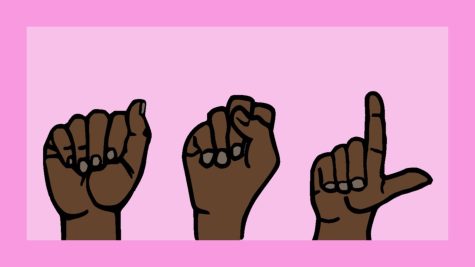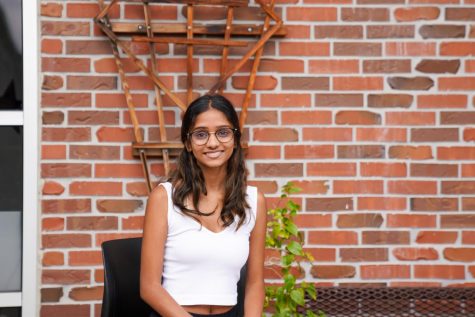Students and administrators discuss methods for helping those who are hard of hearing
Examining the experiences of students with hearing loss and current support systems
February 3, 2022
The students in her elementary school classes always admired junior Myrna Chang’s “colorful ears.”
Born deaf in both ears, Chang realized that she had difficulty mastering vowels in preschool, prompting her to meet with her doctor to check on her hearing. After failing her standard hearing tests, her doctor referred her to an audiologist, where she received hearing aids at 4 years old. Once hearing became easier for her, enunciating her vowels came more naturally and frequently conversing with others strengthened her speaking skills over the years.

In the beginning of a school year, Chang informs her teachers about her hearing issues early so that they can make seating adjustments accordingly. Comparing this to how students with glasses are often seated closer to the front of the room to see, Chang emphasizes that her accommodations are not so different from other students in class. Since she’s used her hearing aids for many years, Chang shares that she’s adapted to her learning environment and daily life, simply asking others to repeat what they said on occasion.
“[Hearing aids] never prevented people from talking to me,” Chang said. “In fact, my classmates would think it was really cool. Normally everyone’s really accepting of it, but even if they forget [that I have them], it’s not that big of a deal — it means that I’m functioning as a normal human being.”
Even if teachers forget to make accommodations, Chang knows that she can still rely on her hearing aids during class. For other students who struggle more significantly with hearing, FUHSD Deaf and Hard of Hearing Specialist Elizabeth Rochin says that teachers can utilize the Hearing Assistive Technology, or HAT, system to aid students in class. The system consists of a small microphone that a teacher wears around their neck to amplify their voice while instructing and turns off during private discussions, a habit that Rochin believes gets easier with practice.
“Even if they forget [that I have hearing aids], it’s not that big of a deal — it means that I’m functioning as a normal human being.” — Junior Myrna Chang
Rochin also explains that students who are deaf or hard of hearing have an Individual Education Plan, or IEP, which guarantees that students with disabilities will receive specialized assistance as needed. These students are appointed a designated case manager at school whom they can refer to for guidance. Students who do not require a higher level of support have a 504 plan instead, which guarantees that students with disabilities will receive necessary accommodations for them to succeed, and can refer to either their assistant principal or guidance counselor for assistance. Throughout the year, Rochin consistently checks in with the case managers across all five schools to set up hearing equipment, explain the HAT system to teachers and create individual year-long goals for the students.
“I’ve worked with students who would really benefit from using their HAT support more consistently, but they are hesitant to do that because it singles them out in class and makes them feel awkward,” Rochin said. “But they’re not getting the full richness of their education if they’re not able to hear the side conversations and jokes in the classroom. When you have a hearing loss, hearing is not an automatic sensory skill — it’s very physically, mentally and emotionally draining to listen and comprehend what’s going on around you.”
Rochin adds that one method students with hearing loss use to comprehend and communicate with others is American Sign Language, or ASL. In the early 2000s, Rochin mentions that a small group of FUHSD students relied on ASL for assistance, but later those students graduated or moved to a high school program with a greater focus on ASL.
While FUHSD does not have any ASL interpreters, MVHS offers a student-run ASL club for students to learn more about the language. Junior and ASL Club’s Vice President of Education Saanvi Mantripragada remembers developing interest in ASL after watching “Switched at Birth,” a show where one of the characters is deaf and uses sign language to communicate. After researching more about sign language and watching some YouTube videos, she decided to join ASL Club for more practice.
“When you have a hearing loss, hearing is not an automatic sensory skill — it’s very physically, mentally and emotionally draining to listen and comprehend what’s going on around you.”
— FUHSD Deaf and Hard of Hearing Specialist Elizabeth Rochin
Each meeting, Mantripragada teaches lessons on various words in ASL, such as modes of transportation and food items. While none of the members have hearing loss, Mantripragada appreciates that ASL creates a safe environment for students in the deaf and hard of hearing community, especially since they are an underrepresented minority at MVHS. In the future, she hopes to collaborate with deaf community members outside of school to further practice their sign language.
“If a student is hard of hearing, whether they know sign language or not, it doesn’t matter because we’re going to start from scratch,” Mantripragada said. “We’re going to help them get there, communicate with them, let them know that even though it might be hard for them at Monta Vista, we’re going to be a club that can help them and that we’re here to support them.”
After the transition to remote learning in 2020, Rochin noticed that the performance of students with hearing loss was much stronger at home without environmental distractions. Now, with the return to in-person school, Rochin finds it critical to ensure that students are keeping their hearing aids clean and charged, and has noticed that students who didn’t use the HAT system before have started to request it this year.
Additionally, according to Rochin, the mask mandate has hindered students’ ability to lip-read, another essential strategy for people who are hard of hearing to communicate with their peers. However, Rochin explains that FUHSD was “very proactive” in solving this issue, distributing thousands of masks with clear panels so that students could easily lip-read in their classes.
“We’re a really well oiled machine at this point,” Rochin said. “We have really strong support from the district office and from the special education department and they’ve equipped me with all the tools that I need at this point to make sure that our students are being well served. That was just a tremendous effort by our district to make sure our students with hearing loss didn’t have any further disadvantage with the masks.”
Graphic by Gauri Manoj
Since there are not many deaf or hard of hearing students at school, Chang notices that students occasionally refrain from asking about her hearing aids to avoid offending her. After having hearing aids for nearly her entire life, Chang shares that she embraces her hearing loss and doesn’t mind sharing her experiences with other students if they’re interested in learning more.
“[To students with hearing loss], just speak up — people are pretty accepting of it,” Chang said. “Just like how people with bad vision have glasses and everyone is OK with it. People think it’s a sensitive thing and maybe to other people it is, but to me, I’m pretty open about it because it’s always been a part of me.”
Before her students leave for college, Rochin hopes to teach them the skills necessary to practice more self-advocacy, as students will no longer have case managers to guide them through school. Rochin would ideally want her students to be able to independently request the accommodations they need at the Disability Resource Center at their respective college campuses, developing important skills for when they work for their first employer. Rochin reflects on the moments when she can “see the light” in her students’ eyes when they finally utilize their technology correctly, thankful that her work truly makes a difference in her students’ lives.
“It’s difficult when you’re an adolescent and it’s all about fitting in and not standing out,” Rochin said. “Things might be going on in their imagination, that people might be teasing them or making fun of them. But it’s just a reality of who they are — it’s a part of how they are engaging with the world. There are all different ways to identify yourself and feel connected — it’s just important to not isolate yourself.”
Click here to hear about MVHS alum ‘20 Adam Wang’s journey with his hearing disability.

















